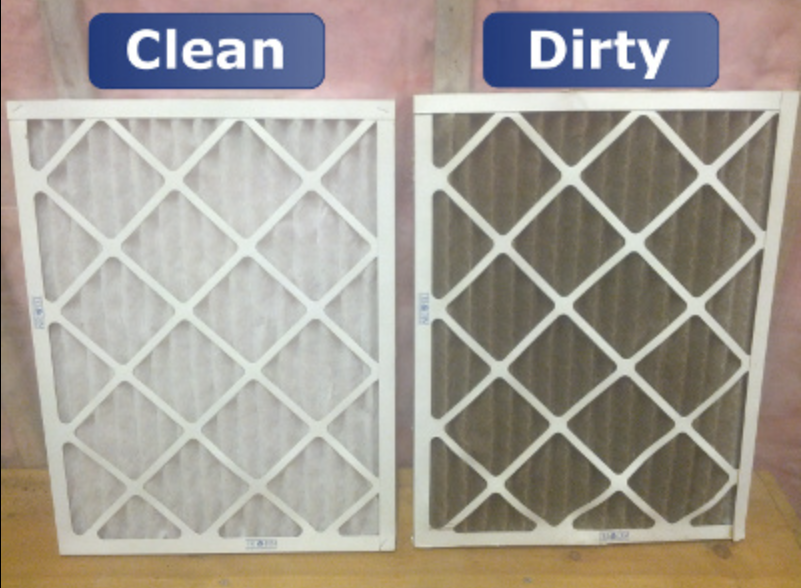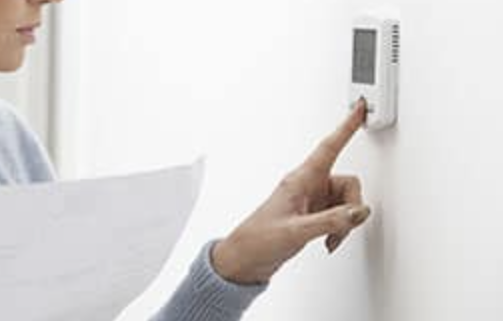Thermostat says Heat on but no Heat? Find out why and Fix it.
Experiencing a scenario where your thermostat indicates “heat on,” yet no warmth emerges from the vents can be both perplexing and distressing. Furnace problems can disrupt your daily life, and the cost of professional service calls can be a burden.
However, there’s a chance that you may not need a technician to restore your furnace to working order.
At a glance: Thermostat says Heat on but no Heat due to Dirty Air Filter,Gas Supply Turned Off,Thermostat on the Wrong Setting,Heater Cut Off from Power Source,Dirty Flame Sensor or Malfunctioning Thermostat.
Before enduring cold temperatures or incurring the expense of a professional inspection, consider trying some DIY troubleshooting steps.
Homeowners can efficiently tackle many common causes of furnace malfunctions, with some solutions as straightforward as flipping a switch.
Related Post>>>>Thermostat Not Reaching Set Temperature.
Common Reasons Why Your Thermostat Says Heat on But No Heat.
1.Dirty Air Filter.

A dirty air filter is a frequent reason for furnaces not producing heat. The air filter’s role is to capture impurities from the air entering the furnace, ensuring the furnace operates efficiently and enhancing indoor air quality.
However, when a filter remains in the furnace for an extended period, it accumulates debris and becomes clogged. This results in restricted airflow, causing insufficient air to be heated and potentially causing the furnace to overheat and shut down.
Solution:
- Locate the Filter: Find the position where air flows into the furnace from the return ducts to access the filter.
- Remove the Dirty Filter: Carefully slide out the old, dirty filter.
- Note Filter Details: Make a note of the filter’s model number and size before purchasing a replacement. Filters come in various types, sizes, and MERV ratings.
- Orientation: Observe the arrow on the replacement filter. Ensure it is positioned so that the arrow points toward the furnace.
- Install the New Filter: Slide the new filter into the slot, making sure it’s securely in place.
- Filter Replacement Frequency: The frequency of filter replacement can vary, but a general recommendation is every 30 to 90 days. Check the filter every month, and if it appears dirty, replace it promptly.
By addressing this common issue with a dirty air filter, you can often resolve the problem of your thermostat indicating “heat on” but no heat coming from the vents.
Regular filter maintenance helps maintain optimal furnace performance and prevents heating problems.
2.Gas Supply Turned Off.

Gas furnaces rely on a steady supply of gas to produce heat. If the gas supply is turned off, your furnace won’t heat your home.
Solution:
- Locate the Gas Valve: Follow the gas pipe from your furnace to find the gas valve. The valve is typically located within six feet of the furnace. The design of gas valves can vary by house, but they often have a red or yellow lever or knob.
- Check the Gas Valve Position: The gas valve is open when the lever or handle is parallel to or in line with the gas pipe. It’s closed when the lever or handle is perpendicular or crosswise to the gas pipe. If the valve is closed, turn the handle or lever parallel to the gas pipe to open it.
- Safety Precaution: If you smell gas at any point during this process, do not proceed further. Turn off the gas valve and immediately contact a professional. Gas has a distinctive sulfuric or rotten egg odor, and it’s crucial to address any potential gas leaks with extreme caution.
- Verify Gas Service: If the gas valve was open, but you’re still not getting heat, contact your gas company to ensure there are no issues with your service, such as unpaid bills or gas line maintenance in your area.
3.Thermostat on the Wrong Setting.

The thermostat plays a crucial role in signaling the furnace when to turn on and heat your home. Incorrect thermostat settings can prevent the furnace from functioning properly.
Solution:
- Temperature Adjustment: Start by increasing the thermostat’s temperature setting by at least five degrees above the current room temperature. This increase can trigger the furnace to turn on. Remember to lower the temperature once the furnace starts heating.
- Check Thermostat Settings:
- Ensure the thermostat is set to the “heat” mode.
- Set the fan setting to “auto.”
- Verify that the temperature setting is higher than the room’s current temperature.
- Make sure the temperature setting isn’t set unreasonably high or significantly different from the outdoor temperature, as this can prevent the furnace from reaching the desired setting.
- Check if there are no conflicting or programmed schedules that may be overriding your desired settings.
Also read>>>>Thermostat Turned Off But Still Blowing Air,
4.Heater Cut Off from Power Source.

Furnaces, including gas furnaces, rely on electricity to function. If the power supply to your furnace is interrupted, it won’t produce heat. This can be due to a tripped circuit breaker or a turned-off power switch.
Solution:
- Check the Furnace’s Power Switch: Locate the furnace’s power switch, which typically resembles an ordinary light switch. It may be positioned near the furnace, but the exact location can vary. Check the sides of the furnace, nearby walls or studs, and ceiling and floor joists. Usually, the “up” position is “on.” If the switch is in the “off” position, flip it to “on” and wait for the furnace to start.
- Inspect the Circuit Breaker:
- Circuit breaker panels are typically found in utility rooms, laundry rooms, basements, or a designated electrical panel area.
- Look for a switch labeled “furnace,” “FAU” (forced-air unit), or “air handler.”
- If the switch is in the “on” position, check if your other appliances have power. If they don’t, a power outage may be the issue.
- If the switch is in the “off” position, flip it to “on.”
- Reset a Tripped Breaker: If the circuit breaker has tripped, the switch will be in the middle “off” position. Flip it to “off” and then back to “on” to reset it. If the breaker trips immediately or frequently, contact a professional to diagnose and resolve the problem.
5.Dirty Flame Sensor.

The furnace’s flame sensor is responsible for verifying that the burners have ignited when the gas valve opens.
If the burners fail to ignite, the flame sensor shuts off the gas supply to prevent the accumulation of flammable gas in your home.
Over time, flame sensors can become coated with soot and carbon deposits, rendering them unable to detect flames. Regular cleaning is essential.
Solution:
- Inspect the Flame Sensor Safely:
- Turn off the power to the furnace using the furnace switch or the circuit breaker.
- Allow the furnace to cool for about 30 minutes if it has been recently running.
- Locate the Flame Sensor:
- Consult your furnace’s manual to find the flame sensor’s location. Typically, you will need to remove an access panel using a screwdriver.
- The flame sensor often appears as a thin, possibly bent metal rod positioned near the burners. It is typically mounted with a quarter-inch hex screw and connected to wires.
- Remove and Clean the Sensor:
- Unscrew the sensor and carefully slide it out of its housing.
- Disconnect the sensor from the wires.
- Examine the metal rod for any blackened or encrusted deposits. If the sensor is dirty, clean it thoroughly.
- Consider Sensor Lifespan:
- Flame sensors typically have a relatively short lifespan of about five years.
- If you notice cracks in the porcelain or if the furnace doesn’t turn on even after cleaning, and the sensor has never been replaced, consider replacing the flame sensor.
6.Malfunctioning Thermostat.

A malfunctioning thermostat can prevent the furnace from turning on or disrupt its operation.
Several factors can contribute to thermostat malfunctions, and addressing them is crucial for maintaining a comfortable indoor temperature.
Also read>>>>Thermostat Clicks But Furnace Doesn’t Turn On.
Solution:
- Weak or Dying Battery:
- Some thermostats are battery-powered. If the battery is weak or dying, it can hinder thermostat functionality.
- Change the battery immediately, and make it a routine practice to replace the battery at the beginning of each heating and cooling season to ensure uninterrupted operation.
- Broken Temperature Sensor:
- A malfunctioning temperature sensor can cause the thermostat to mismeasure the room temperature.
- Temperature sensors typically have a lifespan of five to ten years. If you suspect this is the issue, consider replacing the sensor.
- Dirty Thermostat:
- Accumulated dirt and dust inside the thermostat can lead to malfunctions.
- To clean your thermostat, remove the cover, which may involve unclipping, unscrewing, or snapping it off. Use a paintbrush to gently remove dust and dirt from the thermostat’s components. A dollar bill can be used to slide between closely positioned components to remove debris.
- Inspect the wires for corrosion and loose connections, and if you find wiring issues, consult an electrician.
- Calibration (Mechanical Thermostats):
- Older mechanical thermostats may require calibration if their temperature readings don’t match the actual room temperature.
- Tape a mercury thermometer to the wall approximately an inch away from the thermostat. After fifteen minutes, compare the readings on both devices. If they differ by one or two degrees, calibration may not be needed. If there is a significant variation, clean the thermostat before calibrating it.
- Thermostats may have heat anticipator adjustment levers. If your furnace doesn’t turn on frequently enough, adjust the lever away from the “longer” setting, one mark at a time. Wait another fifteen minutes and compare the thermometer and thermostat readings to determine if further adjustments are necessary.
- Incorrect Installation:
- If the thermostat was recently installed, it could have been done incorrectly. In this case, it’s advisable to call an electrician to assess and potentially rewire the thermostat.
Frequently Asked Questions (FAQs).
Why is my thermostat displaying “heat on,” but my furnace isn’t producing heat?
This issue can have several causes. First, check if your air filter is dirty and clogged, as this can restrict airflow. If that’s not the problem, make sure your gas supply is turned on, the thermostat settings are correct, and the furnace has power.
If all these check out, consider cleaning or replacing your flame sensor. Finally, inspect your thermostat for issues, such as weak batteries or calibration discrepancies.
How do I clean my flame sensor?
To clean the flame sensor, follow these steps:
- Turn off the power to your furnace.
- Locate the flame sensor near the burners, usually held in place with a quarter-inch hex screw and attached to wires.
- Unscrew and carefully slide out the sensor.
- Disconnect it from the wires.
- If the metal rod is dirty, clean it thoroughly. Make sure it’s free from soot and carbon deposits.
- Reassemble and restart the furnace.
How can I determine if my thermostat is malfunctioning?
To identify thermostat issues, consider the following steps:
- Ensure the thermostat has a fresh battery and replace it regularly.
- Clean the thermostat’s components to remove dust and dirt.
- If you have a mechanical thermostat, check for calibration discrepancies using a mercury thermometer.
- If you suspect a malfunction, call an electrician to assess the thermostat, especially if it was recently installed.
Why does my furnace not turn on after I’ve addressed these troubleshooting steps?
If your furnace still doesn’t turn on after you’ve checked the air filter, gas supply, thermostat, and flame sensor, you may have a more complex issue.
It’s advisable to contact a professional technician for a comprehensive diagnosis and potential repairs. Some problems, such as electrical or mechanical issues within the furnace, may require expert attention to resolve.
Conclusion.
Troubleshooting a furnace displaying “heat on” but not producing warmth is a task that can often be undertaken by homeowners themselves.
The most common causes of this issue include a dirty air filter, interrupted gas supply, incorrect thermostat settings, a malfunctioning thermostat, and a dirty flame sensor.
Regular maintenance and careful observation of these components can ensure your furnace operates efficiently.
However, if these DIY steps do not resolve the problem, it’s essential to seek professional assistance to diagnose and address any more complex issues.
Proper maintenance and quick responses to furnace problems are key to maintaining a comfortable and safe home environment.

